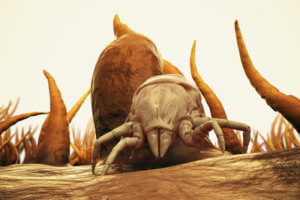What are house mites and dust mites?
Anyone who is allergic to house dust has a big problem with house mites, or house dust mites. The allergy to house dust, or rather to house dust mites, follows you at every turn. It is, after pollen allergy, the second most common allergy.
It is triggered by mite excrement, i.e. the excrements of the house mites. We will examine the subject in more detail:

3d Render mites | © panthermedia.net / 3dmentat
What are (house dust) mites?
Mites (Latin: Pyroglyphidae) are among the arachnids. Contrary to popular opinion, arachnids are not only what we understand by spiders in the conventional sense. They are the eight-legged creatures that mostly weave webs and lurk for prey. Instead, scorpions, mites, ticks and daddy-long-legs also belong to the arachnids.
Description of house mites
The house mite (Dermatophagoides) now also belongs to the arachnids as a genus of mites. In fact, however, there is not one house dust mite, but there are approximately 50 known representatives of the mite, of which a dozen live in house dust (source: Wikipedia).
For Europe the most common house dust mites are these three:
- Dermatophagoides pteronyssinus
- Dermatophagoides farinae
- Dermatophagoides microceras
Size and appearance
Especially the first two mite species make life difficult for people in Europe. In one gram of dust live several thousand, up to about 15,000 house dust mites. At just 0.1 millimetres to a maximum of 0.5 millimetres in size, they are not visible to the naked eye. Under the microscope, on the other hand, the mites and their characteristic jaw claws are clearly visible.
Lifetime
The average life expectancy of house mites is about one month. However, under particularly good conditions, they can reach more than three times this age, namely up to 100 days.
Nutrition
House mites feed mainly on skin scales. A healthy person loses about 2 grams of skin flakes per day. That is, in relation to a mite population, enough for hundreds of thousands to millions of mites. A small part of the diet is also made up of moulds, which are needed for the predigestion of skin scales.
Habitat
With very few known exceptions (e.g. bird nests), the outdoor environment is hostile to the mite. For this reason, house mites are mainly found in human dwellings. The visit by humans alone is enough to repopulate a flat. Usually there are always mites that are carried off with clothing.
Since house dust mites prefer higher humidity (70-80% relative humidity depending on the species) and heat (25-30 degrees Celsius), the preferred habitat of the house dust mite within the apartment is the bed, or more precisely the mattress, pillow and duvet. Often up to 1.5 million house mites are found in a single mattress.
It is important to know that the house mites can also be found in other places: long-pile carpets and couch sets made of upholstery fabric are mentioned here.
Allergy triggers
The house dust mite itself rarely causes allergies. It does not bite or spray poison. The allergic reaction comes from the mites’ faeces, which contain proteins, and from the eggs. A single mite produces around 200 times its own weight in faeces in its short life. If you now imagine that there are more than 1 million mites living in a mattress, you can imagine the amount of mite faeces found in a mattress.
The excrement of the house dust mite decomposes into the smallest dust particles as soon as it is dried. These particles combine with the house dust and swirl through the air. If an allergy sufferer breathes in these particles in the normal way, the typical reactions occur. The nose feels “closed”, the eyes are reddened and you feel a sneezing sensation.
Anyone who does not consistently tackle this house dust allergy, and especially the house mites, runs the risk that the simple allergy will also affect the lungs. This is usually referred to as allergic asthma and the transition of the allergy to the bronchial tubes is called “floor change”.
Summary
Inconspicuously small and invisible to the eye, the house dust mite itself is actually harmless. However, the mite’s faeces can cause severe allergies and allergic asthma. So read our advice pages to find out what you can do about the house dust mite.
